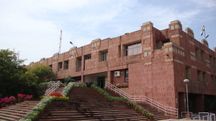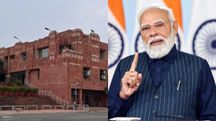Encephalitis Death Toll Rises to 113 in Bihar
 Encephalitis
EncephalitisMuzaffarpur, June 19, 2019:
Children have been dying in Bihar's Muzaffarpur and neighbouring districts due to Acute Encephalitis Syndrome (AES) for over a fortnight, but doctors and heath officials are still in dark about the exact nature of the disease and precise cause of deaths.
The state and central governments are also clueless on the matter. As per official figures, 113 children have died due to AES in Muzaffarpur and neighbouring districts, so far.
Bihar Health Department Principal Secretary Sanjay Kumar said here that of the total 113 deaths, 91 had died state-run Sri Krishna Medical College and Hospital (SKMCH), 16 in the private Kejriwal hospital both in Muzaffarpur, two in the Nalanda Medical College and Hospital in Patna, and 4 in other districts.
This year, 501 AES cases have been reported in the state till date.
Doctors and health officials have different views on the factors behind AES epidemic and the cause of the deaths. This confusion has further complicated the process to combat or control the seasonal outbreak of AES, which has been recurring every year.
Bihar Chief Secretary Deepak Kumar has publicly admitted that even the government is unclear about what exactly was causing the AES outbreak, which has been recorded regularly in Muzaffarpur since 1995.
"We are still not aware if the disease is caused due to some virus, bacteria, toxin effect due to consumption of litchi, malnourishment or due to environmental conditions such as high temperature and humidity," he said.
"Several researches have been conducted, including by a team of experts from the Centers for Disease Control and Prevention, Atlanta (US), but the finding is inconclusive".
SKMCH Chief Medical Officer S.P. Singh said the reason behind the outbreak of the disease was yet to be confirmed. "We don't know it and it was being ascertained medically", Singh said.
Union Health Minister Harsh Vardhan, himself a doctor, who had visited Muzaffarpur three days ago and examined several children in SKMCH, said the deaths could have something to do with electrolyte imbalance and the metabolic system.
He also did not rule out the possibility of AES due to viral infection or toxin effect, which could possibly be caused by the consumption of litchi, as well as high temperature and humidity.
Taking this into consideration, Harsh Vardhan stressed the need for research on AES and setting up of a state-of-the-art, multidisciplinary research unit in Muzaffarpur in collaboration with the Indian Council of Medical Research, the National Centre for Disease Control and AIIMS Patna.
He said there should be research to identify the disease that still not identified and for it research facility should be develop in Muzaffarpur will take support from Atlanta based Centre for Disease Control and WHO for reserach in order to ascertain the causative factor of the disease.
However, Hardeo Manjhi, a landless labourer from Muzaffarpur, whose 4-year-old son is being treated at SKMCH, said: "My son suddenly developed high fever in the early hours last week, followed by convulsions and later turned unconcious, after which, we brought him to hospital for treatment. His condition is showing little improvement".
Manjhi pointed out that most of the children first develop high fever, followed by symotoms like weakness, convulsion, and then lose consciousness.
Marla Devi, mother of a 6 year old child undergoing treatment for AES, said doctors treating her daughter informed that she had lost consciousness due to brain swelling and high fever. "We have noticed only high fever and convulsion", she said.
SKMCH's Paediatricts Department head Gopal Shankar Sahni said the AES outbreak happened during extreme summer.
"We have collected information that suggest that children's body temperatures would shoot up followed by convulsion. They also suffer from hypoglycaemia (very low blood sugar) to shortage of sodium".
Rajiv Kumar of Kejriwal Hospital said it was common for children struck by AES to suffer from mental disorientation after the sudden onset of fever.
"In such a situation, we have been advising parents to bring their children to the nearest PHC or hospital without delay for treatment. Chances of survival increase with early arrival"," he said.
Most of the child victims of AES belong to poor and marginalised sections, including Dalits, Other Backward Classes (OBCs), Economically Backward Classes (EBCs) and Muslims.
"AES victims are mostly the malnourished children from underprivileged sections of society, they are from categories below the poverty line (BPL)", said a district health official in Muzaffarpur.
After Chief Minister Nitish Kumar visited Muzaffarpur on Tuesday , the government has commissioned a survey in blocks and villages which reported high death toll to study the socio-economic profiles of the affected families and their living conditions.
A team of experts sent by the Central government has expressed dissatisfaction over the weak health infrastructure and poor hospital facilities.
Keep following Inside Northeast on Facebook, Youtube, Twitter, and Instagram. Do download our app from the Google Playstore for the latest news updates, views, and entertainment on the go. We deliver the Northeast.
Copyright©2026 Living Media India Limited. For reprint rights: Syndications Today









